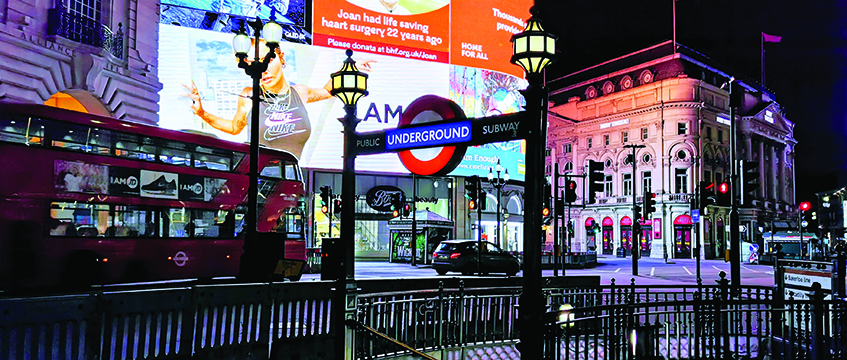Unlike virtual reality, which is fully immersive and where the real world disappears from view entirely, augmented reality is more nuanced and enables digital assets to be layered over physical assets, like a building.
AR is a global trend which is having a significant impact on the out-of-home advertising arena – the world’s largest digital billboard is stationed in Times Square, New York. The six-storey board features cutting-edge technology, harnessing 3D design and elements of mixed reality. In May of last year, the Maslow was unveiled, namely Africa’s largest 3D digital billboard, based in Lagos, Nigeria. Here in the UK, Europe’s second-largest digital billboard is sited at Victoria Warehouse in Manchester. On-building digital advertising is experiencing a dynamic renaissance, where the traditional barriers of screen-size and two dimensions are being pushed to their very limit.
Eye-catching technology
Size isn’t everything, of course, and what’s really capturing the public attention is 3D anamorphic displays. These billboards trick the viewer’s perception by presenting a 2D video but in such a way that it gives the illusion of 3D, all visible to the naked eye. Imagine a giant branded trainer rotating so as to appear to be dimensional and leap out of the screen towards the viewer without the need for 3D glasses; that illusion of depth is the selling point of this technology.
It is easy to see the appeal for advertisers as traditional billboards can only display one advert at a time. It can take precious hours (sometimes days) to replace old adverts with new, whereas digital billboards allow businesses to promote a continuous stream of changing adverts cyclically. More than that, digital billboards deliver personalisation and further erode the lines between entertainment and advertising. In the metaverse, viewers have the ability to interact with adverts within a replica of the real world.
In the battle for consumer attention, truly unique designs can trigger the public to share the content on social media, meaning they only need to be sited in one physical location. This one-site approach allows the creators of the designs to focus on being as captivating as possible with the advantage of costs being allocated to one screen only.
Considerations for property owners
Owners of buildings on which these digital screens are fixed benefit from their ever-growing popularity, with the income derived from these mixed-reality boards delivering much higher rents. Although most screens are rented to billboard operators, ownership of the asset itself, and the intellectual property in its design, can come with its own significant value. The iconic Piccadilly Lights billboard in London is cited to be one of Landsec’s most valuable assets.
With the concept of immersive advertising evolving, and with more businesses using this technology to advertise in both the real and the virtual world, there are some challenges. First, practical installation: including securing of planning consent, the reality of any site-specific restrictions, and the construction and ongoing maintenance of the asset. Will there be a one-off capital payment or is an ongoing leasing arrangement needed?
There is a clear need for sensitivity as to location, use and content of such billboards. Some sites adjacent to residential areas are subject to campaigning by organisations looking to prevent use between the hours of 10pm and 6am, to save energy and reduce light pollution.
From a regulatory perspective, critically, there are no specific laws in England and Wales relating to AR and VR. As immersive advertising combines both what is “real” and what is digital, there is little choice currently but to rely on numerous existing laws (in the fields of data protection, intellectual property and advertising, to name but a few) to attempt to plug the gaps. Given the digital nature of these assets, they can potentially be accessible in multiple jurisdictions with competing regulatory framework, meaning that virtual billboards are subject to a whole host of complex and multilayered restrictions. The growing use of AR and VR for advertising highlights the need for a robust legal framework to address the specific issues that may arise as a result of this new technology.
Digital rights
Much in the same way that non-fungible tokens confer ownership of digital assets, property digital rights exist and are an emerging asset class enabling property owners to register a property’s digital rights and use in an immersive environment. Legislation in England and Wales needs to catch up, and the Property (Digital Assets etc) Bill, introduced to parliament in September 2024 (in response to a 2023 report from the Law Commission) is intended to deliver some much-needed clarity and legal frameworks around these digital assets.
For the moment, in the same way interests in a physical property may be registered at the Land Registry, property owners may now consider registering their interests in any property digital rights on digital advertising platforms in order to protect their use and increase revenue. As the industry becomes commonplace, we will likely see more sustained regulatory input, echoing the stringent control shown by the Land Registry towards property interests, in ensuring proper use of these assets.
Hollie Wright is an associate in the real estate division at Shoosmiths LLP








